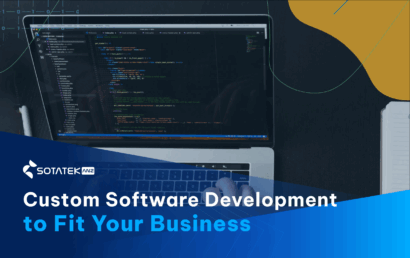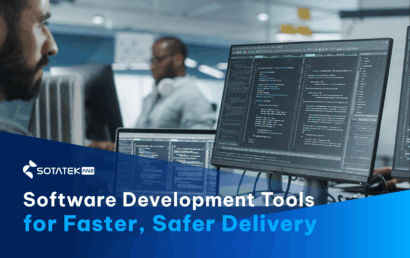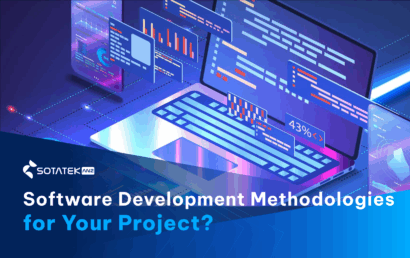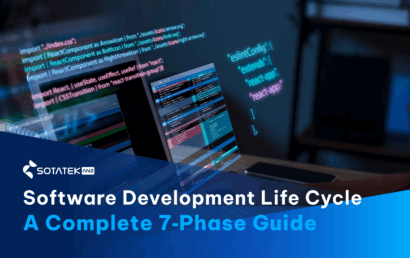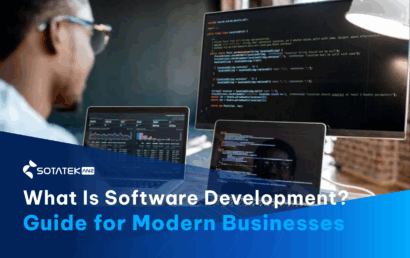Introduction
As markets become more dynamic and customer expectations continue to rise, businesses across Australia and New Zealand are under increasing pressure to modernise their operations. Traditional systems are no longer equipped to provide the speed, flexibility, or intelligence required to stay competitive. In response, SAP development has become a strategic driver of digital transformation, empowering organisations to automate workflows, access real-time insights, and build a resilient, future-ready foundation for growth.
At SotaTek ANZ, we specialise in delivering end-to-end SAP development services tailored to the unique needs of businesses in the region. Our team helps clients unlock the full potential of SAP solutions, from system integration and cloud enablement to intelligent automation and continuous innovation.
Read more: What is SAP? 4 Key SAP Modules and Applications for ANZ Businesses
The Urgent Need to Modernize Your Systems
Across Australia and New Zealand, many businesses are still operating on legacy ERP systems or outdated technology stacks. These systems, once considered reliable, are now becoming barriers to growth. They cause operational slowdowns, require excessive manual handling, and lack the flexibility needed to scale or integrate with new tools. In fast-moving markets, such limitations can be costly.
A recent survey of over 1,000 Australian business leaders revealed a striking gap between digital ambition and reality. While 90% have started digitalising their operations, only 18% are fully digital. The difference this makes is significant. Companies with fully integrated systems are nearly four times more likely to realise ROI within a month. Moreover, 77% outperform their peers across key business metrics.

Current level of digital integration in Australia
Digital transformation is no longer just a strategic buzzword. It’s a top priority. In KPMG’s latest CEO Outlook, 53% of Australian executives named digital transformation and unlocking value as their primary challenge for the year ahead.
Yet despite these clear benefits, many organisations remain stuck. In 2025, legacy ERP systems continue to hold back industries like manufacturing. They increase operational costs, limit scalability, and reduce competitiveness. More critically, outdated systems expose businesses to higher risks, from compliance issues to missed market opportunities.
The takeaway is clear. Modern, integrated systems empower businesses to move faster, operate smarter, and respond with agility. Falling behind is no longer a slow fade; it’s a real risk. For any company that aims to lead in a digital economy, system modernisation is not optional. It’s urgent and essential.
SAP Development is now Mainstream in Australia and New Zealand
Modern ERP systems are no longer reserved for large enterprises. Today, SAP adoption in Australia & New Zealand is accelerating across industries, driven by the rise of cloud-based platforms, increased IT investment, and embedded AI capabilities that deliver measurable business value. SAP development has firmly entered the mainstream, offering scalable, future-ready solutions for both mid-sized and large organisations.
Cloud ERP Revenue Is Climbing Fast
Cloud-first adoption is rapidly reshaping the ERP landscape. According to IDC, cloud ERP revenue in the Asia-Pacific region, including Australia and New Zealand, is projected to grow at double-digit rates through 2026. This reflects a broader shift in digital strategy: businesses are choosing flexible, subscription-based platforms that lower infrastructure costs while enabling faster innovation. As legacy systems fade out, SAP’s cloud-based offerings such as SAP S/4HANA Cloud are gaining strong momentum. This growth clearly signals a rising SAP adoption in Australia & New Zealand, particularly among companies seeking agility and long-term value.
ERP Investment in Australia Is Growing
Across the region, organisations are investing heavily in ERP transformation. Recent industry surveys show that ERP and core digital infrastructure now rank among the top five IT investment priorities in Australia. From retail to manufacturing, local businesses are leveraging SAP development to integrate operations, enhance visibility, and future-proof their workflows.This steady rise in SAP adoption in Australia & New Zealand reflects a clear recognition: modern ERP is a critical foundation for sustainable growth.

Australia Enterprise Resource Planning Market Outlook
Embedded AI Is Driving Efficiency
Artificial intelligence is no longer a standalone add-on; it’s being woven directly into the heart of ERP platforms. SAP latest technologies embed AI and machine learning to automate repetitive tasks, generate predictive insights, and flag anomalies in real time. For finance teams, supply chains, and customer-facing functions, this means fewer manual bottlenecks and smarter decisions, faster. As SAP adoption in Australia & New Zealand grows, more businesses are realising that embedded intelligence is a necessity for staying competitive in 2025 and beyond.
Find more details in our latest whitepaper Why 2025 is the Tipping Point for SAP Adoption in ANZ
Top 5 Benefits of SAP Development
SAP adoption in Australia & New Zealand continues to grow, therefore, businesses are seeing more than just operational improvements. They’re building a strategic edge. SAP development offers a robust digital foundation that supports automation, agility, and innovation across the enterprise. Whether you're a SME or a large organisation, here are five key benefits you can expect from adopting SAP solutions:
Streamlined Operations Through Automation
Manual processes slow down business. SAP development helps eliminate repetitive tasks by automating workflows across departments like finance, HR, and supply chain. With built-in process intelligence and real-time data flow, businesses can reduce human error, shorten cycle times, and free up staff for higher-value work. This leads to more efficient, standardised operations that scale easily as the business grows.
Real-Time Visibility and Better Decision-Making
SAP systems consolidate data from across the business into a centralised, accessible platform. This creates a single source of truth that supports accurate reporting and timely decisions. With real-time dashboards and predictive analytics, leaders can track KPIs, anticipate risks, and respond faster to changes in customer demand or market trends. In competitive sectors, this agility is crucial.
Scalability That Supports Long-Term Growth
As companies expand, they need systems that grow with them. SAP development enables modular expansion and flexible configuration that aligns with your business model. Whether you’re entering new markets or adding new business units, SAP platforms can support growth without needing disruptive system overhauls.
Enhanced Compliance and Risk Management
Staying compliant with local and international regulations is increasingly complex. SAP solutions come with built-in compliance frameworks, audit trails, and user access controls that simplify governance. For businesses in highly regulated industries like finance, energy, or manufacturing, this reduces exposure to compliance risk and makes audits easier to manage.
Future-Readiness with AI and Innovation
SAP is at the forefront of embedded AI and intelligent automation. Its platforms support innovation by integrating seamlessly with technologies like machine learning, IoT, and advanced analytics. This positions businesses to adapt quickly, whether that means using AI for demand forecasting, optimising inventory, or enhancing customer experiences. As digital transformation accelerates across the region, this future-ready infrastructure becomes a key competitive differentiator.
The Cost of Waiting
Delaying digital transformation may seem like a safe choice, but in reality, it’s often the most expensive. Legacy systems drag down productivity, making processes slower and stifling innovation. Meanwhile, maintenance costs continue to rise, migrations become riskier, and expected returns on investment fade. Without timely updates, businesses are also exposed to increasing security vulnerabilities and compliance risks — legal consequences that can be both disruptive and costly.
Beyond internal challenges, the competitive landscape doesn’t wait. As other organisations embrace AI, IoT, and integrated platforms, late adopters risk missing out on key capabilities and market opportunities. Competitors gain speed, flexibility, and negotiation power while those clinging to outdated systems fall behind. In short, the longer you wait, the greater the risk. Taking action today means fewer disruptions tomorrow and a faster path toward future-ready operations.
Conclusion
For businesses in Australia and New Zealand, the move toward modern, intelligent systems is now a competitive necessity. SAP development offers a powerful pathway to streamline operations, improve decision-making, and future-proof your business in a rapidly changing landscape. The risks of delay are real, but so are the rewards of acting early: increased efficiency, stronger compliance, and the ability to scale with confidence.
If your organisation, be it start-ups or SMEs or large business, is ready to take the next step, SotaTek ANZ is here to help. Get in touch with our SAP experts today to explore a tailored development strategy that aligns with your goals, and sets your business up for long-term success.


